


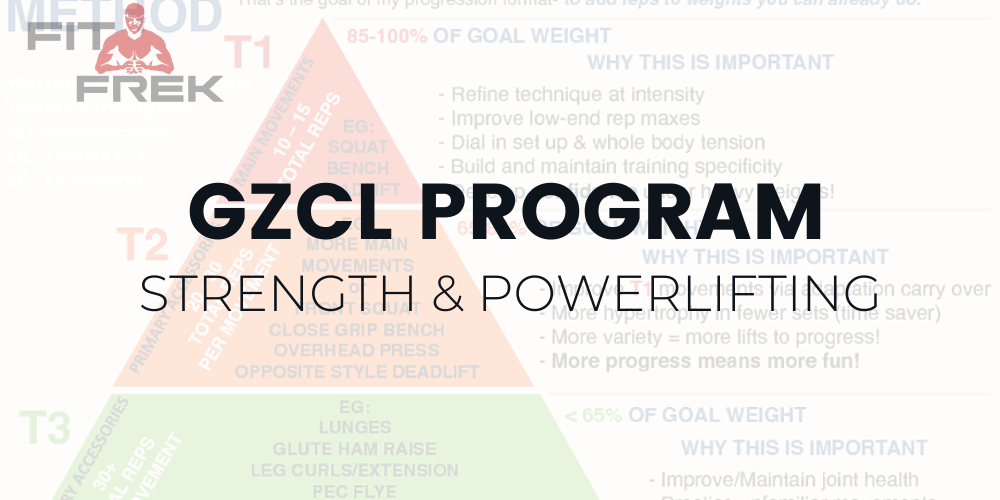



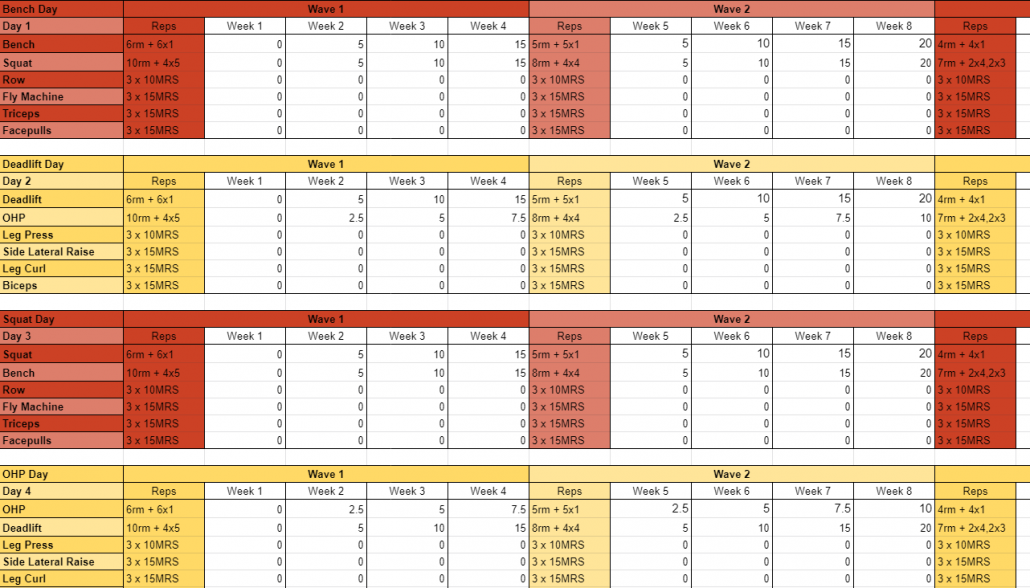
GZCL is made from a well known Reddit user who goes by /u/gzcl.
He created this program as a method to improve powerlifting.
GZCL is more of a framework than a program.
It's based on Jim Wendler's 5/3/1. It uses a training max (90%) with 4 week cycles and AMRAP sets.
Most of the included spreadsheets will calcuate lifts for you.
Make sure you make a copy of the spreadsheet. For how to save spreadsheet instructions, click here.
If you want to improve your strength and numbers, then GZCL may be the right program for you.
GZCL is a simple program that is based on the 4 big lifts, squat, bench press, deadlift and overhead press.
It categorizes these exercises into three types (T1, T2, and T3), which you'll see and understand below.
Welcome to the world of the GZCL Method.
A strength-building program that's been making waves in the fitness community.
Developed by powerlifter and strength coach Cody Lefever, this method is all about customization, progression, and most importantly, results.
But what exactly is the GZCL Method, and how can it help you reach your fitness goals?
Let's dive in.
The GZCL Method is a flexible powerlifting program focusing on volume, intensity, and frequency.
It's designed to help lifters of all levels build strength and muscle mass, with a structure that can be customized to individual needs and goals.
At the heart of the GZCL Method is the principle of volume, intensity, and frequency.
This means that your workouts are structured around a certain number of exercises (volume), performed at a certain level of difficulty (intensity), and repeated a certain number of times (frequency).
The idea is to balance these three elements to maximize gains and minimize the risk of injury.
But the real beauty of the GZCL Method lies in its flexibility.
Unlike many other strength programs, the GZCL Method allows you to customize your workouts to suit your individual needs and goals.
Whether you're a beginner looking to build a solid strength base, or an experienced lifter aiming to smash your personal bests, the GZCL Method has got you covered.
The GZCL Method is built around three tiers of exercises.
Tier 1 exercises are your main lifts, such as the squat, bench press, and deadlift.
These are the exercises that you'll be performing at the highest intensity, and they form the backbone of your training program.
Tier 2 exercises are supplementary lifts that support your main lifts.
These are performed at a lower intensity than your Tier 1 lifts, and they're designed to help you build strength and muscle mass in specific areas.
Finally, Tier 3 exercises are accessory lifts that target smaller muscle groups.
These are performed at the lowest intensity, and they're designed to help you balance out your physique and prevent imbalances that could lead to injury.
The GZCL Method also includes a progression scheme that guides you on increasing the weight and volume of your lifts over time.
This ensures that you're constantly challenging your muscles and progressing towards your goals.
One of the standout features of the GZCL Method is its flexibility.
The program is designed to be adaptable, allowing you to tailor your workouts to your individual needs and goals.
This means that you can adjust the volume, intensity, and frequency of your workouts to suit your current fitness level and future aspirations.
Whether you're looking to build muscle, increase strength, improve endurance, or combine all three, the GZCL Method can be adjusted to help you achieve your goals.
In fact, there are several different variants of the GZCL Method, each with its own unique characteristics and benefits.
These include the GZCLP for beginners, Jacked and Tan 2.0 for those looking to build muscle and strength, and The Rippler for those looking to improve their powerlifting performance.
The GZCL Method is not just a theory – it's a proven system for building strength and muscle mass.
Many lifters have reported significant improvements in their performance and physique after following the program.
The key to the GZCL Method's effectiveness lies in its focus on progressive overload and recovery.
Progressive overload is the principle of gradually increasing the stress placed on your body during exercise.
In the context of the GZCL Method, this means gradually increasing the weight you lift, the number of repetitions you perform, or the frequency of your workouts.
This constant challenge stimulates your muscles to grow stronger and larger.
But equally important is recovery.
The GZCL Method emphasizes the importance of rest and recovery to allow your muscles to repair and grow.
This balance between work and rest is crucial for achieving optimal results with the GZCL Method.
NOTE: Please make a copy by clicking File > Make (requesting edit access is incorrect). For how to save spreadsheet instructions, click here.
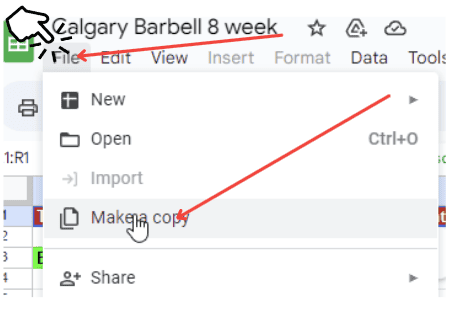 (Read above first) Spreadsheet
(Read above first) Spreadsheet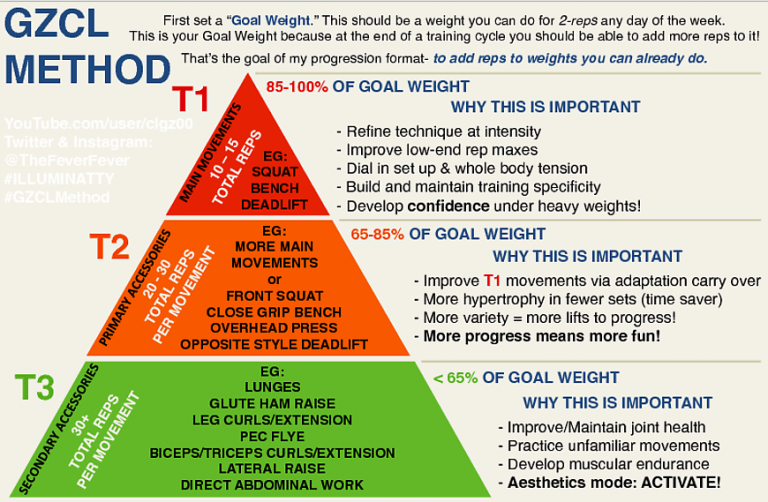
Rather than a strict program, GZCL is a method for a framework as it can be used in a training program that you're already using.
Since it's a framework, you'll find many variations of the GZCL program in the spreadsheet below.
Many more may come in the future as it's a popular framework to use.
If you want to help Cody Lefever, the creator of GZCL, please consider donating to him.
Read this post by /u/GZCL before going into any General Gainz spreadsheets.
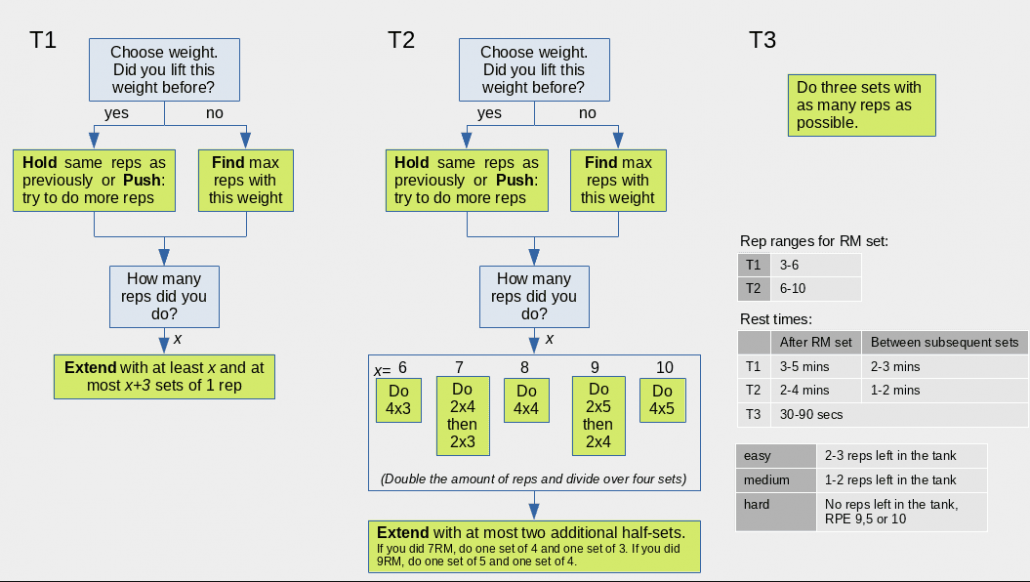
Before using this spreadsheet (created by /u/K-S-R), check out this post by /u/ctye85
You'll find the UHF program in the GZCL free compendium, which is similar, but this uses a heavy single in each workout and it's inspired by the RTS programming methods).
It's made to use heavy singles in training with different lift, percentage, rep schemes than the regular UHG program.
And you only progress the heavy single weight if you were able to perform a clean rep the week before.
Cody's guidelines…
For the Max Rep and AMRAP sets, leave 1-2 reps in the tank.
If you feel drained then, for the rest of the week, leave 2-3 reps in the tank and deload the volume by reducing T3 work by one set.
And increase calorie intake by 250-500 calories for the next 2 days while increasing sleep by 30-60 minutes.
This is a variation of the GZCLP, made by /u/blacknoir:
This one is a variation of the original Jacked and Tan program, made by Reddit user /u/JosphusBroz:
GZCL Max Reps by Cody:
This one focuses on upper body hypertrophy. Squats are 3x per week, and bench press 2x per week. No deadlifts.
After the 3rd week, check what lifts have improved and adjust training max for next cycle.
Made by reddit user /u/gluteusofaluminum:
Redditor /u/theAesir made this with GZCL principles and used tweaks that helped this lifter.
Uses templates for GZCL linear progression program and 3 week GZCL style program. This one us made for novice to intermediate level users.
Straightforward to original GZCL methods made by reddit user /u/durable and edited by /u/point3edu and approved by GZCL
Check out this summary from Reddit user /u/Tommy92db.
Inspired by Jim Wendler's 5/3/1, GZCL is a method of programming using training max (90% of 1 rep max) with 4-week cycles and AMRAP sets to test progress. GZCL uses many variations to it's methods, like Ripper, GZCLP, Jacked & Tan 2.0 and more.
Choosing the Right GZCL Variant for You
The beauty of the GZCL Method lies in its adaptability.
With several variants to choose from, you can select the one that best aligns with your fitness level and goals.
Let's take a closer look at some of the most popular GZCL variants.
GZCLP
GZCLP is the beginner-friendly variant of the GZCL Method.
It's designed to introduce new lifters to the principles of volume, intensity, and frequency, while also teaching them the fundamentals of the main lifts.
GZCLP follows a linear progression scheme, meaning you'll aim to add weight to your lifts every workout.
This makes it a great choice for beginners looking to build strength and muscle mass quickly.
Jacked and Tan 2.0
Jacked and Tan 2.0 is a variant of the GZCL Method designed for those looking to build muscle and strength.
It follows a block periodization scheme, with different phases focusing on different aspects of fitness.
This variant is a great choice for intermediate to advanced lifters looking to break through plateaus and achieve new personal bests.
The Rippler
The Rippler is a GZCL variant designed to improve powerlifting performance.
It focuses on the main powerlifting lifts – the squat, bench press, and deadlift – and follows an undulating periodization scheme.
This makes it a great choice for powerlifters looking to improve their competition lifts.
Implementing the GZCL Method
Once you've chosen the right GZCL variant for you, it's time to put it into action.
Remember, the key to success with the GZCL Method is consistency and progression.
Stick to your program, strive to improve every workout, and don't forget to prioritize recovery.
Similar to GZCL, GZCLP is a program that uses the same principles but with linear progression.
It's great for novice lifters since it progresses faster.
The lifts are categorized into 3 T categories.
Starting with T1 lifts, these are primary exercise movements like squats, bench press, deadlifts, or overhead press. they are the priority of the training session.
The T2 lifts are a variation of the T1 lifts, like front squats, deficit deadlifts, incline bench press, exercises that bodybuilders would perform.
T3 lifts are accessory exercises that are done in high rep ranges.
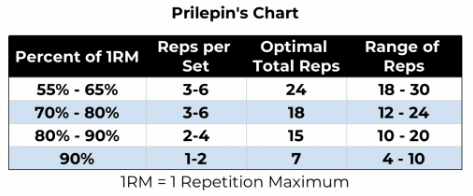
Sure, here are some frequently asked questions about the GZCL Method:
1. What does GZCL stand for?
GZCL stands for the initials of its creator, Cody "GZCL" Lefever.
2. What is the difference between GZCL and GZCLP?
GZCL is the original method developed by Cody Lefever, while GZCLP is a variant of the method designed specifically for beginners.
3. What are T1, T2, and T3 lifts in the GZCL Method?
T1, T2, and T3 refer to the three tiers of exercises in the GZCL Method. T1 lifts are your main lifts, T2 lifts are supplementary lifts, and T3 lifts are accessory lifts.
4. How does the GZCL Method help in building strength and muscle mass?
The GZCL Method helps in building strength and muscle mass by focusing on volume, intensity, and frequency. It also emphasizes the importance of progressive overload and recovery.
5. Can I customize the GZCL Method to suit my needs?
Yes, one of the key features of the GZCL Method is its flexibility. You can adjust the volume, intensity, and frequency of your workouts to suit your individual needs and goals.
6. How often should I work out with the GZCL Method?
The frequency of your workouts will depend on the specific GZCL variant you're following. Most variants recommend working out 3-5 times per week.
7. How do I choose the right GZCL variant for me?
Choosing the right GZCL variant depends on your fitness level and goals. GZCLP is best for beginners, Jacked and Tan 2.0 is great for those looking to build muscle and strength, and The Rippler is ideal for powerlifters.
8. What is the progression scheme in the GZCL Method?
The GZCL Method includes a progression scheme that guides you on how to increase the weight and volume of your lifts over time. This ensures that you're constantly challenging your muscles and making progress towards your goals.
9. What is the philosophy behind the GZCL Method?
At the heart of the GZCL Method is the principle of volume, intensity, and frequency. This means that your workouts are structured around a certain number of exercises (volume), performed at a certain level of difficulty (intensity), and repeated a certain number of times (frequency).
10. Is the GZCL Method suitable for beginners?
Yes, the GZCL Method is suitable for beginners. The GZCLP variant is specifically designed for beginners and provides a structured plan to guide new lifters on what to do on a particular workout session along with the weight to choose.
The GZCL Method is a versatile and effective strength-building program that can be tailored to individual needs and goals.
By focusing on volume, intensity, and frequency, and emphasizing the importance of progressive overload and recovery, the GZCL Method helps lifters of all levels build strength and muscle mass.
Whether you're a beginner looking to build a solid strength base, or an experienced lifter aiming to smash your personal bests, the GZCL Method could be the key to unlocking your full potential.
Remember, the key to success with the GZCL Method is consistency and progression.
Stick to your program, strive to improve every workout, and don't forget to prioritize recovery.
With the right approach, the GZCL Method can help you achieve your strength and fitness goals.



Useful Links
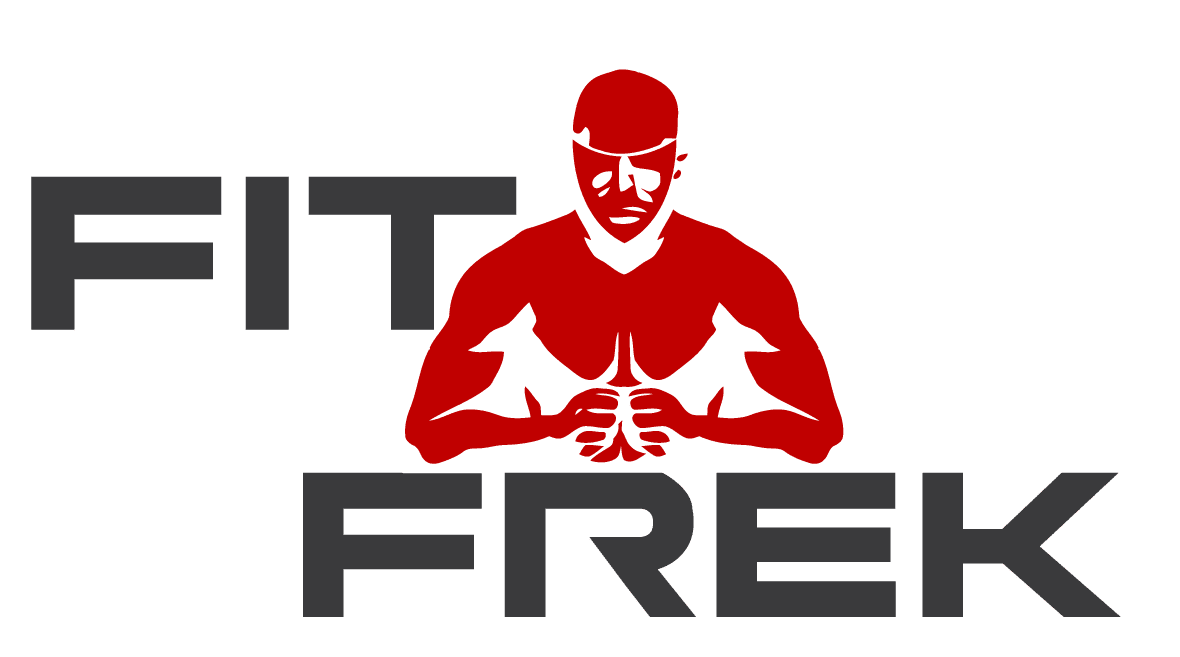 About FitFrek
About FitFrekFitFrek operates as an independent platform, offering comprehensive workouts, programs, routines, guides, and unbiased reviews to accelerate your progress. We pride ourselves on our honesty, delivering straightforward and candid insights. FitFrek does not offer medical advice, diagnosis, or treatment services.